Mongolia
2 Chapter Investment Environment
-
-
1 Chapter Basic knowledge
2 Chapter Investment Environment
2.4 Investment regulation and incentives
3 Chapter Establishment
3.1 Characteristics of business base
3.2 Establishment of business base
3.3 Liquidation and withdrawal
4 Chapter M&A
4.2 Laws and regulations concerning M & A
5 Chapter Corporate Law
5.1 Organization of the company
6 Chapter Accounting
7 Chapter Tax
7.2 Individual Issues of Domestic Tax Law
7.5 Tax survey and tax penalty
8 Chapter Labor
8.4 Foreign Employees in Mongolia
9 Chapter Q&A
-
-
-
Economy
Mongolia is a developing country below 100th GDP world, but continues to achieve high economic growth against the backdrop of abundant underground resources. Moreover, it has a unique geographical condition sandwiched between two major powers of Russia and China and has a potential to experience a big turning point from socialism.
■ Changes in GDP and Economic Growth Rate
The Mongolian economy has been growing at a very high rate since 2000. Due to the impact of the global financial crisis, we experienced a negative growth in 2009, but after that we recovered V-shaped and continued high double-digit growth from 2011 to 2013.
The background to this is the growth of retail, manufacturing and construction industries, the abundant underground resources of Mongolia, among others, mineral prices such as copper and gold, have risen due to global supply and demand tightening. There is no doubt that the influence of China's economic trends and the international price fluctuation of underground resources on the largest export destination will have a large impact on the Mongolian economy, but despite of China's slowing economic growth, It has been successful to grow rapidly. However, in 2014 the growth rate remained at 7.8% due to the slump in the mineral industry. A low growth rate of 4.4% is projected in 2015 as well.
One of the reasons for this is the unstable economic policy of the Mongolian government. Foreign exchange declined due to a decline in foreign direct investment, and the depreciation of Tugulg led to an economic downturn. Therefore, in 2015, the Mongolian government negotiated to revive the Au Trojo Project, which occupies a large share in the mining industry, and concluded a contract on May 19, 2015. This project is expected to have a positive impact on Mongolian economic growth.
GDP per capita was less than US $ 500 in the early 2000s, but in 2013 it has risen to US $ 4,563. However, in FY 2014 it has declined to US $ 4,512.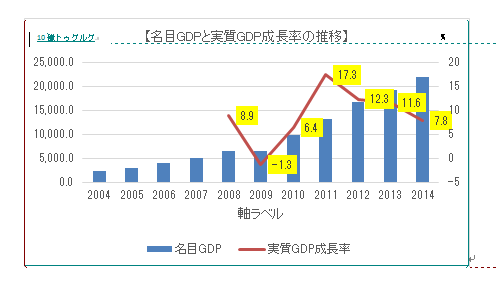
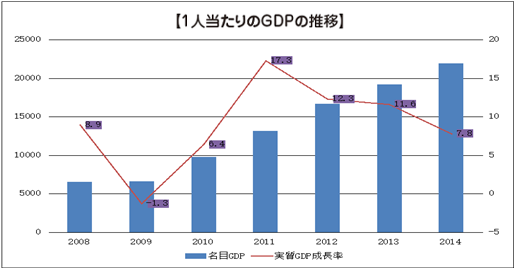 出所:National Statistical Office of Mongolia(モンゴル国家統計局)
出所:National Statistical Office of Mongolia(モンゴル国家統計局)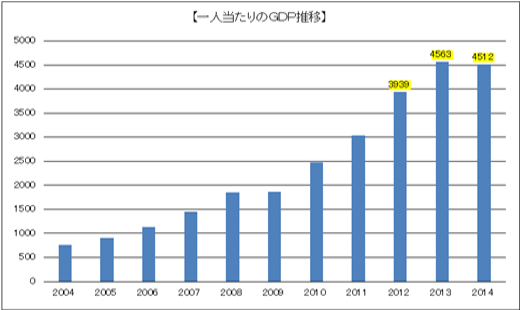 出所:National Statistical Office of Mongolia(モンゴル国家統計局)■ Trends in National FinanceIn the past 10 years, both expenditure and expenditure have increased nearly tenfold. The increase in expenditure is thought to be a major factor that expenditure, which is said to be "a dispersion policy", was committed every time the general election. For example, there are benefits such as civil service salary increases and pension payments raise many times, newly-married family benefits, child allowances etc. In addition, in 2010, according to the commitment to "redistribute profits from resource development ahead of schedule to the public," 120,000 Tugrug per person, 270 million Tugulg total was paid to about 2.7 million people.The increase in revenue also contributes greatly to mining based on abundant underground resources and cashmere industry traditionally strong. However, it means that the soundness of national finances depends on fluctuations in international prices such as resources.Therefore, in 2010, the National Congress passed a bill to stabilize the fiscal budget by establishing a "budget stabilization fund" and keeping the budget deficit to within 2% of GDP as a percentage of GDP. However, the budget deficit has expanded in 2011 and 2012, and in fiscal 2012 it became 6.7% of GDP. After that, although it fell to 1.1% in 2013, it rose to 3.7% in 2014. At the same time, it will be necessary to simultaneously achieve a number of goals such as inflation suppression, economic growth and increased personal income at the same time as fiscal consolidation, and the Mongolian government is confronted with several important issues.
出所:National Statistical Office of Mongolia(モンゴル国家統計局)■ Trends in National FinanceIn the past 10 years, both expenditure and expenditure have increased nearly tenfold. The increase in expenditure is thought to be a major factor that expenditure, which is said to be "a dispersion policy", was committed every time the general election. For example, there are benefits such as civil service salary increases and pension payments raise many times, newly-married family benefits, child allowances etc. In addition, in 2010, according to the commitment to "redistribute profits from resource development ahead of schedule to the public," 120,000 Tugrug per person, 270 million Tugulg total was paid to about 2.7 million people.The increase in revenue also contributes greatly to mining based on abundant underground resources and cashmere industry traditionally strong. However, it means that the soundness of national finances depends on fluctuations in international prices such as resources.Therefore, in 2010, the National Congress passed a bill to stabilize the fiscal budget by establishing a "budget stabilization fund" and keeping the budget deficit to within 2% of GDP as a percentage of GDP. However, the budget deficit has expanded in 2011 and 2012, and in fiscal 2012 it became 6.7% of GDP. After that, although it fell to 1.1% in 2013, it rose to 3.7% in 2014. At the same time, it will be necessary to simultaneously achieve a number of goals such as inflation suppression, economic growth and increased personal income at the same time as fiscal consolidation, and the Mongolian government is confronted with several important issues..jpg)
Inflation
The Mongolian consumer price index has been an upward trend for the last ten years. However, the inflation rate has been fluctuating since around 2005, it will record 28% in 2008, and in 2009 will settle to single digits due to cold consumption due to the global financial crisis, but then again in 2012 crude oil. A high inflation rate of 14.3% was taken from factors such as price and grain price rising, China's inflation as the biggest import destination, etc.
In the IMF forecast, the inflation rate in FY 2015 is 9.2%, the consumer price index is 161.34.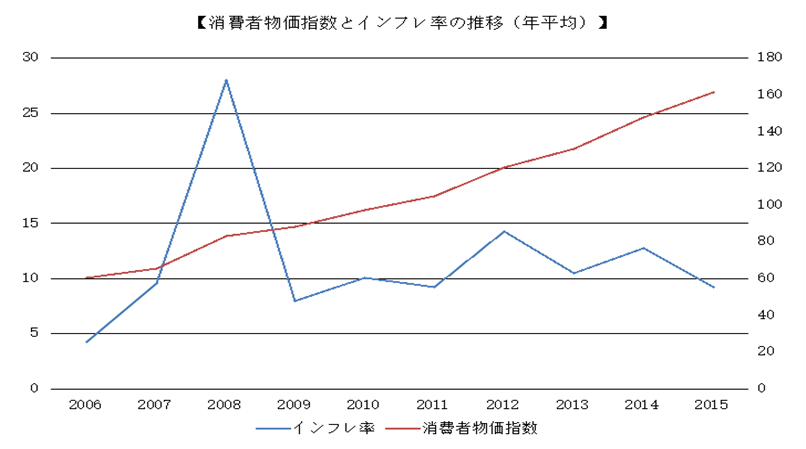 ※ The consumer price index is an index with December 31, 2010 as 100Source: National Statistical Office of Mongolia (Mongolian State Statistics Bureau),IMF 'World Economic Outlook Database, October, 2015'
※ The consumer price index is an index with December 31, 2010 as 100Source: National Statistical Office of Mongolia (Mongolian State Statistics Bureau),IMF 'World Economic Outlook Database, October, 2015' -
Trade
Both exports and imports have increased dramatically in the past 10 years, which is about ten times. In 2009, both imports and exports declined due to the impact of the global financial crisis, then recovered in 2010 and 2011, but it decreased again in 2012 and beyond. However, the trade balance for fiscal 2014 has been in the black since 2006.
There are many mining products exported to China, imported goods are rich in petroleum from Russia, exports to China are exceeded, and imports to Russia are over imports.
【貿易収支の推移】.png) 出所:National Statistical Office of Mongolia(モンゴル国家統計局)
出所:National Statistical Office of Mongolia(モンゴル国家統計局)
■ ExportLooking at export destinations from Mongolia by country, China is overwhelmingly large among 59 countries. In 2014 the ratio further increased to 88% of the total export value..jpg)
.jpg) By product, mining products account for nearly 90% of the total, both in terms the amount and ratio due to the international demand increase and the soaring price. Breakdown of mining products is coal 49.4%, crude oil 17.4%, iron ore 16%, copper concentrate 16%. In addition, Mongolia traditionally flourished with sheep farming produces woolen fabrics and leather products such as cashmere, 5.9% of textile and textile products, 0.6% of leather, furs and their products are exported in proportion to 0.6%.
By product, mining products account for nearly 90% of the total, both in terms the amount and ratio due to the international demand increase and the soaring price. Breakdown of mining products is coal 49.4%, crude oil 17.4%, iron ore 16%, copper concentrate 16%. In addition, Mongolia traditionally flourished with sheep farming produces woolen fabrics and leather products such as cashmere, 5.9% of textile and textile products, 0.6% of leather, furs and their products are exported in proportion to 0.6%.
.png)
-
Industry trends
Two of the most important areas for considering the industrial composition of Mongolia are industrial and agriculture and farming. The mining and manufacturing industry (mining, manufacturing, construction) accounts for the largest share of GDP as 35%, driving economic growth in Mongolia.
On the other hand, traditional Mongolian agricultural farming accounts for 14% of GDP, but when looking at the labor force's population it is 28.59%, the largest, and it is still an important industry where many people still work. Just to add, 14.65% of the working population is serving retail, automobile, motorcycle repair services. As a result, nearly 50% of the total labor force is working in these two industries.
Along with economic growth, there are signs of growth in the secondary and tertiary industries in the country, but basically it is not easy to see the growth of primary products such as minerals and agriculture and miscellaneous goods and the monoculture economy. The tendency still remains strong.【主要産業の対GDP比(2014年)】.png) Education 1.9%Manufacturing industry 5.4%Construction 1.9%Transportation · Warehouse 11.0%Source: National Statistical Office of Mongolia (Mongolian State Statistics Bureau)
Education 1.9%Manufacturing industry 5.4%Construction 1.9%Transportation · Warehouse 11.0%Source: National Statistical Office of Mongolia (Mongolian State Statistics Bureau)
■ MiningMongolia was known as a country where abundant nonferrous metals such as copper, gold and molybdenum and coal are abundantly reserved, but since 2009 it attracted worldwide attention. Mineral resources are ranked high worldwide. As stated above, the mining industry is the main industry of Mongolia, alone has 18% of GDP and 83% of exports.
As a Mongolian mine known worldwide, the Oyu Tolgoi mine located in Uum Nugobi Province, under the development agreement between Canada's Rio Tinto (66%) and the Mongolian government (34%), has been operating since 2009. The reserves of the Oyu Tolgoi mine was calculated in 2014 and have been revised to be 44.595 million tons of copper, 1,900 tons of silver, 11,900 tons of gold and 205,000 tons of molybdenum.
The other is also the largest reserves of the Tavan Tolgoi mine located in Uumnegovi Prefecture, the world's largest 6 billion tons, of which about 1.4 billion tons is coking coal to be a raw material for steelmaking, 4.6 billion tons is energy coal . Tavan Tolgoi mine started production and export to China by state development Erdenes Tavan Tolgoi company independently developed. In addition, since coal produced in this coal field it is "raw coal" necessary for the steel industry and energy industry, Russia, China, Japan, Korea, the United States, sharpened in order to acquire further development rights It is.
There are several promising uranium deposits in the eastern Dornodo prefecture. The Golvan Borag ore deposit was acquired by a Canadian capital enterprise by a company in China, Later, it was acquired by a Chinese company in 2009. Regarding the Dornod deposit, companies in Russia and Canada competed for mining rights, but in August 2009 Russian President Medvedev visited Mongolia and signed a joint development with Mongolia. Against this background, you can see that Mongolia is a place of intense competition for international resource acquisition.
Since 2009, the above-mentioned two mining industries developed in Mongolia, Mongolia's mining industry developed, the economic growth rate in 2012 and 2013 became two figures. Meanwhile, following the change of the regime in June 2012, foreign direct investment regulations were strengthened, which greatly reduced foreign direct investment, which led to the shortage of exchange rates and the depreciation of Tugrugu expanding, Mongolia faced an economic depression.
With strengthened foreign capital regulation, it became difficult for foreign companies to invest in Mongolia, and the production volume of mining enterprises such as Oyu Tolgoi and Tavan Tolgoi was also declined. Worldwide price reduction of mineral products has become a major reason for the Mongolian economic downturn.
Since June 2013, the government began to move to avoid the economic crisis, and again, we began taking policy such as revising the law to accept foreign investment companies' investment. As a result of two years tense negotiations, RioTinto and the Mongolian government agreed on the development plan and financing plan on May 20, 2015, and the mine development project of US $ 5.4 billion scale will be advanced. If full-scale production begins, Oyu Tolgoi expects to produce 450 thousand tons of copper, 330 thousand tons of ounces per year on average, and produce large amounts of silver and molybdenum. This movement seems to greatly contribute to the future Mongolian economy.
Regarding the exploration situation, according to JOGMEC information, in addition in banning the grant of new mining rights, the mining area maintenance fee regulation stipulated in the Mineral Resources Law stipulates that the percentage of mining areas in the country is from 44.5% in 2005 to 2013 It is decreasing to 9.4%. As a result, in 2013, 3,018 (9.4% of the country's 147,026.9 km 2) mining rights were granted. It consists of 1,717 exploitation rights and 1,301 digging rights.
As for new definite reserves in 2013, 33,478 t copper, 4,180 t, 34.8 t tungsten, 103,553 t iron ore, zinc 202, 495 t, lead, 9,791 t, rare earth 52 t, iron ore 11,455.4 th t, coal 4.4 billion 517 t, fluorite 2,804 thousand tons, etc. were registered in "National Mineral Resources Reserve Register".
.png)
.png)
■ Livestock farmingAbout 80% of Mongolia is said to be a pasture land, traditionally livestock industry by grazing is flourishing. Sheep, goats, cows, horses etc. are kept as the main domestic animals.
Traditionally pastoral sheep keeping sheep by traditional grazing was the mainstream, but in recent years cashmere has increased cash income, so the number of goats has increased and it has reached the same number as sheep.
As goats get uprooted pasture grassland recovery is slow, it is easy to invite desertification, pastoralists newly entering for cashmere production tend not to move for protecting meadows etc. There are concern about deterioration of the natural environment. The Mongolian government is taking steps to prevent the increase of goats by promoting sheep to promote wool industry.
Pasture livestock by grazing is greatly affected by climate. When winter is warm, the number of livestock increases and decreases in cold weather by the rare severe cold which is said to be "Zodo". In early 2010, the record number died in all the livestock species, and the number reached 10 million heads. Livestock production has declined by nearly 20% compared to the previous year, as well as those who engaged in livestock breeding have received a major blow, as well as the rise in meat prices boosted the consumer price index and had a huge impact on the Mongolian economy I gave it. In 2011 we have somewhat gentle climatic conditions, the number of heads has been steadily recovering in 2012, and finally we returned to the level from 2013 to 2009.
According to the announcement by the National Bureau of Statistics (2014), the median monthly income by Mongolian industry is the highest in the financial sector, then the mining industry. Agriculture and fishery is about 270,000 tugrugs, which is less than 30% of finance. While high economic growth continues in Mongolia, the slump of pastoral livestock farming occupying the largest working population and the reality of being exposed to severe weather are unchanged from the past, eliminating the gap between rich and poor is a major issue.
For this reason, the Mongolian government approved the "National Livestock Program" in 2010, and has been working on pasture livestock and its surrounding areas such as pasture management, livestock registration system, human resource development, measures against infectious diseases, training of meat and dairy products processing and export promotion Is positioned as a national project and promoting it.
.png)
Source: National Statistical Office of Mongolia (Mongolian State Statistics Bureau)
-
-
-
Investment environment of Mongolia seen in the questionnaire result
On October 29, 2014 the World Bank announced the "Current Business Condition 2015". Mongolia ranked 72th in this ranking world ranking and 10th in Asia Pacific countries ranking..png)
In the ranking of 2015, items with Mongolian ranking higher than the overall ranking are five, "start of business", "registration of assets", "fund procurement", "protection of investors" and "performance of contract" . -
Financial (stock) market
The Mongolian government established the Mongolian Stock Exchange in 1991 during the transition period of the market economy. Legal systems such as the enforcement of the Securities and Exchange Law, establishment of securities stations, privatization of securities brokers, revision of the securities market law, etc. were carried out, and the Mongolian Stock Exchange was re-established as a state-owned corporation in 2003.
The Mongolian Stock Exchange has 237 listed companies (as of 2015) and is falling from 336 companies in 2012. This is caused by the economic downturn and the regulation of stock exchanges. In 2013, the securities market law was revised and ranked for share issuers. As a result, the stock was divided into three ranks. The first ranked condition includes corporate governance code, which has a market evaluation of more than 10 billion Tugurugu, a citizen holding rate of 25% or more, a high liquidity, a well-known and highly profitable corporation. However, at this time the company entering this rank does not exist in Mongolia.
The second rank condition includes small and medium enterprises whose securities are traded on a regular basis and which have a market evaluation of more than 500 million Tugrug and more than 2 years, currently 89 companies are registered.
The third rank includes small and medium-sized enterprises with high risks, 100% state-owned enterprises and companies that have stopped securities transactions from the financial management committee, and 148 companies are registered here.
In fiscal year 2014, 137 companies' 51 million (51,700,000) shares were traded in 24 billion (24,200,000,000) Tugrug with a total of 255 transactions. Total 86 thousand (86, 900 thousand) Tugulg trade was executed on average, and 162,900 (162,900) shares were traded. However, 95% of total transactions are transactions with 30 companies.【証券取引】.png) Source: Mongolian Stock ExchangeUnder the Securities Market Law system up to 2013, it was difficult for foreign companies to publicize their stocks, but after the revision, conditions opened to foreign companies also came to be attached.
Source: Mongolian Stock ExchangeUnder the Securities Market Law system up to 2013, it was difficult for foreign companies to publicize their stocks, but after the revision, conditions opened to foreign companies also came to be attached. -
Exchange rate
Looking at the long-term trend in Tsugurugu versus the yen, it has fluctuated around 10 average tugulugs on average until 2000-2008, but since 2009 the tuggle low has advanced, and in 2012 it has reached 18.14 tugurugu. As of the end of June 2015, it has been moving around 16 Tugulg. .
Regarding tuggle versus the dollar, it was stabilized at 1,300 units until 2013, but after February 2013 the toggle went down without stopping and in March 2015 it went up to 1986.22, and create a record with the first ever in history. However, this rate is the rate of Mongolian banks, which is nearly 2,000 in commercial banks. It is attributed to the fact that the mining industry has been stagnant rapidly and the flow of foreign exchange has stagnated.
Also, although the balance of payments statistics of the Mongolian bank's announcement showed that inward direct investment spilled more than US $ 100 million for the second consecutive quarter, foreign exchange reserves fell 2.8% compared to the end of the previous month.
Although it is predicted that resource export by mining development will increase in the long term and there is also a prediction that it will be high Tuggul, there are instability factors such as high inflation rate in the short term, so if you move it in a state where the upper and lower fluctuations are large for a while.
【Tugulg (MNT) vs. yen / dollar】 ⑩.png)
.png) Source: Bank of MongoliaSource: www.oanda.com
Source: Bank of MongoliaSource: www.oanda.com
■ Foreign direct investmentForeign direct investment
The Foreign Direct Investment (FDI) to Mongolia has continued to grow for the past 10 years, exceeding US $ 1 billion in 2010. This is about 10 times more than 10 years ago. Furthermore, it reached 4.9 billion US dollars, which is about five times that in 2011.
By type of industry, "geological survey and coal mine" is overwhelmingly large, accounting for over 70% of the total. The biggest factor caused by the rapid increase in FDI in 2011 is the fact that foreign investment in investigation and development of promising veins has become very popular. Although the number of investments itself has declined since the global financial crisis, the amount base continues to rise because the large number of investments in the "geological survey and coal mine" sector is increasing.
【Trends in Foreign Direct Investment】.png)
.png) Source: Mongolia Ministry of Foreign Investment and Trade
Source: Mongolia Ministry of Foreign Investment and Trade
[Percentage of investment by industry from 2009 to 2013].png) Source: Mongolia Ministry of Foreign Investment and Trade
Source: Mongolia Ministry of Foreign Investment and Trade
Investment from Japan is also on the rise. In addition to the fact that Mongolian government has provided various technical assistance since the transition period of democratization of Mongolia, the Mongolian government seeks strategic strengthening of partnership with Japan in order to reduce dependence on both China and Russia. There is a background that there is. -
Infrastructure situation
According to the World Competitiveness Report of 2014-2015 published by the World Economic Forum, infrastructure in Mongolia is 119th among 144 countries, infrastructure development is considerably delayed. The railway is ranked 69th in the sole order to a certain extent, but the road is at 130th place, the port is at 143th place, the air transportation is at 125th place, which is very low ranking.
However, since 2012, we are actively focusing on infrastructure development, and there are many new railroads, construction of airports and construction of new roads.
In particular, it is a problem to deal with the power shortage which is problematic due to delays in the development of land transport infrastructure, which is a life line for inland countries, and rapid population growth in the capital city of Ulaanbaatar.
■ RailwayAs of 2015, Mongolia has 1,905 kilometers of railroads spread. Among them, 1,807 kilometers are owned and used by the Ulan Bator Railway established in 1949 by the joint investment of the Mongolian government and the Russian railway company 50% each. Therefore, it is in a state that monopolizes infrastructure of almost all Mongolian railroads independently.
In Mongolia, railway is the most important means of transport and is indispensable for freight transport. Most of freight transport is done by rail. In particular, the north-south longitudinal railway linking China and Russia plays an important role. Railway transport is expanding to export iron ore produced in northern Serengue prefecture to China and exporting coal from coal mines in the southern Gobi region to Russia, and further improvement is urgently needed.
In recent years attention gathered from all over the world to subsurface resources buried in various parts of Mongolia has become a development boom. The securing of these stable means of transportation is positioned as a national priority. The Mongolian government considered China and Russia, thought that desired to get out of dependence on both countries, the route selection was changed frequently, but three routes were to be developed. The plan includes a route from the world's largest Tawantorgoy coal field in the southern Gobi area to the Russian route via the northeastern Choibalsan and the route from Futuo to the Chinese border in the eastern part. Both are important routes to ensure access to Russia and China and important consciousness of exports to both countries.
As a result, the Mongolian government granted Mongolian Railway State-owned Corporation a license to improve the 1,800-kilometer railway on the 1st and 2nd routes of the "New Railway" project on November 3, Mongolian Railway State Administration Co., Ltd. is a 100% state-owned company and was founded in 2008 to meet the development of Mongolian mining industry.
Outline of "New railway"Position: As shown below, 1,800 km of railwayTabang · Torgoyi → Gashawn · south (South direction): 225 kmTabang · Torgoy → Huto: 960 kilometersFoot → Choibalsan: 185 kilometersChoibalsan → Elenzantab: 210 kmFoot → Vichigo: 230 kilometers
Total budget: So far between 6 billion and 8 billion US dollarsPurpose: to enable access to world markets through ports of China and Russia, to give Mongolian mining enterprises more profitable conditions.png)
A roadIn Mongolia, the road transport network is not maintained in many areas except the capital city of Ulaanbaatar and its surroundings, Daruhan, El Denete and some other cities. It is said that there are 70,000 km of roads, but the paved road is only about 20%. Many of the rest are gravel roads, solidified soils, and in rural areas, there are many cases where they are simply referred to as roads where the cars ran into the meadow, and in the case of four high. In many cases it requires a wheel drive car.
There is also an adverse effect on the pasture land due to the fact that the local development does not proceed because the long distance cannot move smoothly and the car runs chaotically in disorderly manner. For this reason, the Mongolian government decided to develop an approximately 5,000 km national highway connecting the region and the capital city of Ulan Bator, and construct a highway of approximately 1,000 km as an important item of infrastructure development.In Ulaanbaatar, daily traffic congestion due to rapid population increase is a problem. Wide roads were originally constructed in the socialist era, but the improvement of roads has not kept up with the increase in automobile holders due to high economic growth. Distribution of population and urban functions not only by urban road improvement but also by the development of satellite cities is urgently required. For this reason, after 2013 the driving will be restricted by the day of the week by the end of the car number. While the school is closed from June to September, traffic congestion is relieved, but instead of frequent road construction work, traffic congestion often deteriorates.
AirportLocated about 10 km from Ulaanbaatar city, Genghis Khan International Airport is the only international airport in Mongolia. The annual number of users was 200,000 in 2002, but it increased to 102 million by 2015. Due to economic growth, further increase is expected in the future.
However, at the same airport there are mountains on the extension of the runway, and the takeoff and landing from the north side is restricted because it is located in the mountainous area. There are many problems such as delay due to unseasonable weather and absence of cancellation. For this reason, the construction of a new airport with a runway of about 3,600 m in Tubu province, 50 km southwest of Ulaanbaatar, is proceeding. To this project, Japan’s ODA loan of 28.8 billion yen is scheduled to be offered, and in 2017 we plan to start the project.
Direct flights from Mongolia are currently taking place between Korea, China, Japan, Russia, Germany, Hong Kong and Turkey. There are MIAT Mongolian Airways and Hunu Air, the largest share of domestic and international flights for airlines.
PowerMongolian power generation is dominant in thermal power generation using coal abundantly produced in the country. However, many of them were operated under the technology and financial support of the former Soviet Union, and as a result of raising funds for management after democratization, maintenance and renewal of facilities could not be done, and the amount of electricity generated by power generation with poor efficiency The risk of accidents due to equipment troubles, air pollution and mass emissions of CO 2, etc. have come to have many problems. In Mongolia, thermal power plants not only supply electricity but also supply thermal energy with hot water. In Mongolia where the coldness is severe, the peak of energy demand is in winter, and many citizens use hot water for heating. As a result, the unstable driving situation of the power plant has had a serious impact on the civic life in the winter season. Until now, we have been disappointing with purchasing electricity from Russia etc. However, in order to solve the fundamental solution, we are updating facilities and building a new power station.Furthermore, as large-scale mining development and economic growth progress, electricity demand is expected to increase rapidly. In order to respond to the increase in demand, construction of power plants and improvement of transmission lines by foreign aid and private investment are advancing at a rapid pace. In addition, the development of renewable energy in the outskirts of Ulaanbaatar and the construction of the Saruhito wind power plant began, and securing electricity is being addressed as a priority issue.Under the principle of market economy introduction, the power station was privatized and became an independent profit system. However, the right to decide supply quantity and electricity price is in the Energy Regulatory Agency, and the electricity price is kept politically low. For this reason, most of the power plants continue to be in the red, and Mongolian power systems are said to have structural problems that do not conform to the market economy principle. Response measures were resolved by the 2010 National Conference in 2010, and after 2010 the price of utility expenses will be raised from the previous year. Electricity rates are roughly divided into four types, households, mining enterprises, other factories and public facilities. In FY 2014, the electricity price of companies conducting mining projects rose sharply, and from 108.5 Tugrugu in 2012 to 162 Tugrugu in 2014..png)
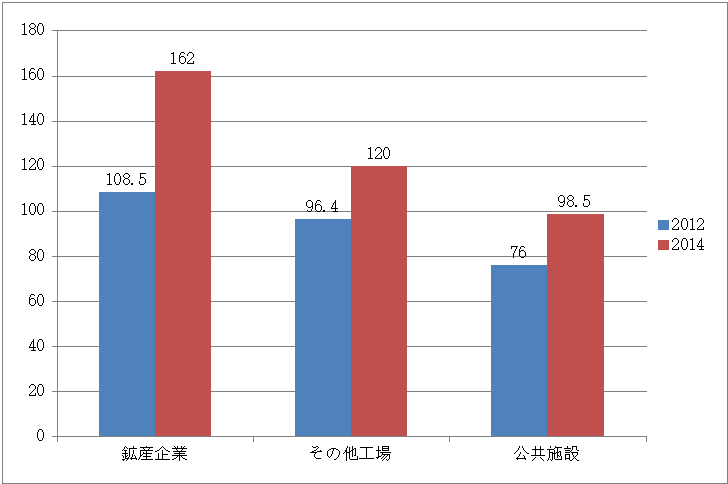
CommunicationIn Mongolia mobile phones are rapidly spreading, and the number of mobile phone subscribers as of 2015 is 3.352 million. Since 1999 Mobicom, a joint venture between Sumitomo Corporation and KDDI, provides services under the GSM method.
【Number of Subscribers and Penetration Rate of Cellular Phone】 Unit: Thousand people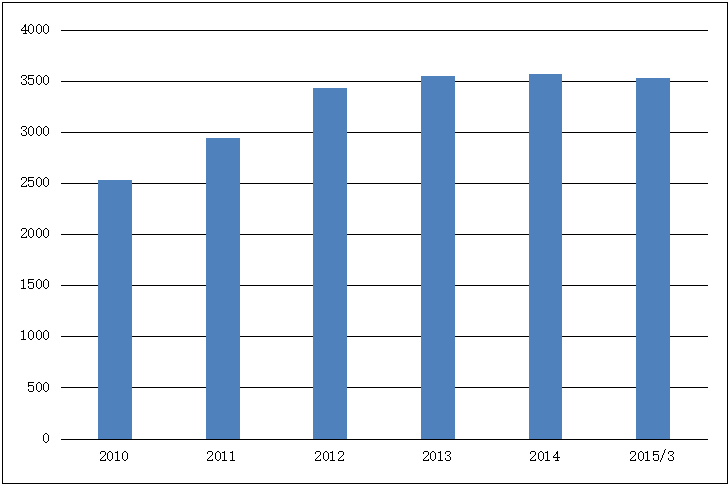 Source: National Bureau of Statistics
Source: National Bureau of Statistics
-
-
-
Industrial park
The industry in Mongolia is mainly agriculture and farming, and industrial products almost depend on imported goods, so industrial parks have not been established. However, attention to abundant mineral resources has gathered from the world, and construction of industrial parks is planned even in Mongolia.
Due to the government decision in 2011, the establishment of an industrial park to sign shandang approved about 450 km southeast of Ulaanbaatar was approved. The signshand is the capital city of Dronoungovi province, and in accordance with the approval of this plan, various projects are starting to move with signshand, especially the construction of roads and railways is preferentially implemented.
It is estimated that if the industrial park is opened, the share of industrial sectors in GDP will rise to 57%, and the economic growth rate will be 15.8% on average in 2013-2021.
The construction of the industrial park is underway led by Bechtel in the USA, and the creation of the master plan has been completed. The sign shand industrial park mainly deals with the development of heavy industries such as coke, steelmaking, metallurgy and copper smelting plants for domestic processing industries and exports, development of minerals such as Oyotrongoi and Tawantorugoi, power plants.
Annual production capacity is assumed to be 2 million tons of coke, 450,000 tons of cathode copper, 4.5 million tons of iron balls, and 1 million tons of concrete, but construction of the coke plant and chemical plant is started first. In addition, it is necessary to secure the construction of comprehensive transport facilities and water supply facilities, and it is being kept pace with response. The factory operation is expected to be in the middle of 2018.
With the construction of industrial parks, more than 10,000 jobs are planned to be created, and there are also plans to create new towns around 20,000 people. Currently, at science and technology universities and vocational schools, we are also recruiting engineers who wish to find employment in the same industrial estate. Each developed country is also showing a cooperative approach to human resource development, but Japan's International Cooperation Agency (JICA) also proposes to develop Mongolian government about 450 engineers.
It is expected that such industrial parks will continue to increase in the future and we can expect a positive impact on the economy, and as a result of the introduction of manufacturing industry, so we need to keep closely watching the trend.
-
-
-
Investment regulation
Foreign investment in Mongolia was conducted based on the Foreign Investment Act until 2013, but the Foreign Investment Act was abolished from November 2013, and the new Investment Law and the Investment Fund Act were enacted. This was an eliminated discrimination between foreign investment and domestic investment. Also, with the abolition of the Foreign Investment Act, the Foreign Investment Management Act on Strategic Industries, which had become a major obstacle to foreign investment in Mongolia was abolished.
When traced back the history of the law, Mongolia since 2011, it will be exposed to interest known to be the rich in the world mining resources industry, which by foreign direct investment in Mongolia has increased at once, become the GDP growth rate for the first 2 time Ketadai mine It became a boom. However, countermeasures have been taken to reduce foreign investment due to the fact that Mongolian legislation has not kept up with this economic development and growth, resistance to mining development by the private sector, and the embarrassment of the government. As a result, the "Foreign Investment Management Act for Strategic Business", "The Law to Prohibit Resource Exploration and Mining at River Water Resources Protected Areas and Forest Reserve" and "Law to Stop the New Issue of Resource Exploration Licenses" And others were enforced one after another.
This caused distrust of foreign investors. The investment in Mongolia continued to decline. Mongolian foreign exchange reserves declined due to sluggish business and foreign investment in foreign companies that had been doing business in Mongolia, Tuggurg's depreciation advanced and in Thailand US dollar it became close to 1,400 to 2,000 in 4 months. Furthermore, due to misunderstandings of business contracts with Au Trogoi, one of the major mining projects, some businesses ceased and nearly 1,000 employees were dismissed.
What the government has taken as a countermeasure against the economic depression enters the legislation to attract foreign investors, and as stated above, the new investment law and the investment fund law are established and the foreign investment management law for strategic industries is abolished. In addition, the agreement of the Au Trojo Project was able to be agreed.
Apart from the Investment Law, investment in specific industries is restricted regardless of internal or foreign capital by the Special Business Permit Law. If it falls under a particular type of business, you must obtain approval from relevant ministries beforehand.
■ Industries for which investment is prohibited
The prohibited industries are the following four projects ; (Article 8 of the company special permission law).
· Manufacture, import and sale of drugs
· Organization, advertisement, encouragement in a form contrary to public order and morals
· Casino business
· Sales of MLM and pyramid type for profit purposes
■ Industries with restricted ownership ratio
In Mongolia there is no special foreign capital regulation concerning the equity investment ratio.
■ Industries that require prior approval
There are no restrictions on the shareholding ratio, but in doing business there are specific industries that must obtain prior approval from related ministries and agencies. Regulated industries are decreasing year by year, but as the contents are divided finely, it is difficult to judge whether or not it is applicable, and it takes time and effort to obtain approval. The list of regulated industries is as follows (Article 15 of the Business Special Permit Law).
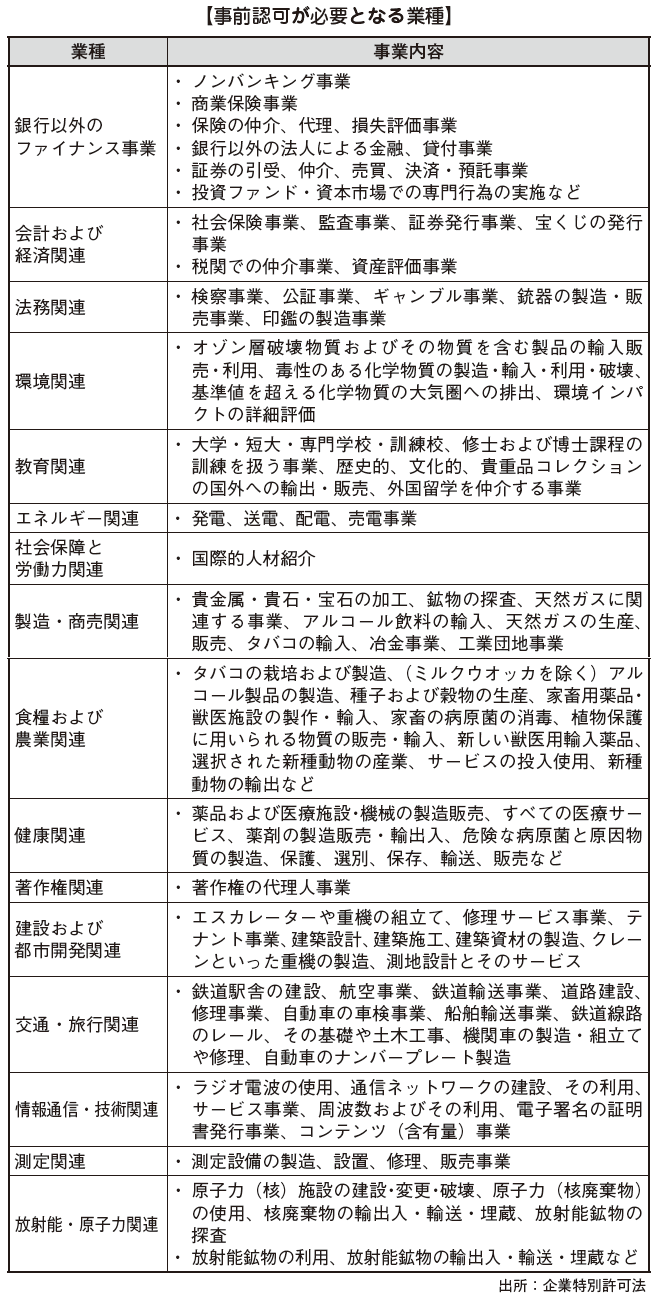
When investing in these regulated industries, apply for licenses at each relevant ministries and agencies in Mongolia and register. The following documents are required for license application of regulated industry type;
· License acquisition application form (enter business details, type of business, period)
· In case the license applicant is a company, a corporate registration certificate from the corporate registry authority
· Copy of national certificate (notarized notary) if license applicant is individual,
· Receipt paid for certificate fee
· Other documents required by law due to its production, business characteristics
After applying for the above documents, the result will be received within 30 days from the Registration Authority.
[Period of license, extension]
Licenses are issued in principle for a period of 3 years or more, but depending on the type of industry, it may be shorter than that. The term of the license can be extended, and it takes about 3 days for the extension procedure. However, if you find that it violates the terms of the license, you cannot obtain the extension permission. -
Other regulations
■ Capital regulationWith the establishment of the new investment law, the regulation of minimum capital concerning of the establishment of the company has been abolished. Meanwhile, we were able to receive incentives for taxation, if we meet the conditions specified in the Investment Act and the capital requirement. However, with regard to specific industries, the minimum capital is stipulated individually as follows.
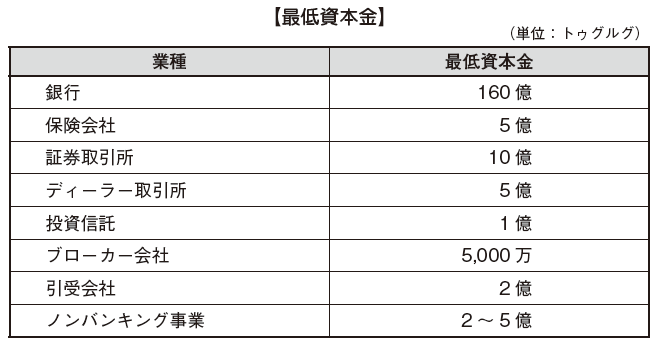
■ Land ownership regulation
In Mongolia, according to the Constitution, only individuals who are Mongolian citizens are allowed to possess land, and it is impossible for corporations and foreigners to possess land in Mongolia.
Foreign corporations and foreigners can acquire the license for a certain period of time by contract between the local government in the jurisdictional area and the owner Mongolian for the private property for state-owned land.
■ Foreign exchange regulation
In Mongolia there are relatively few restrictions on foreign exchange. (e.g. there are no special restrictions on borrowing from the parent company or remittance to overseas. However, you need to prove whether you earn money earned in Mongolia when you transfer money.) -
Investment incentives
The following incentives will be granted to companies that meet the conditions of the Investment Act. There are two types of incentives given to investors, tax system and non-tax system.
■ Tax incentive measures
We will give the following incentives to investors (Investment Act 11.1).
·duty free
· Tax reduction
· Calculated by way of accelerating depreciation cost deducted from taxable income
· Calculated by moving the deficit deducted from taxable revenue to the future
· Calculated by deducting the training cost of employees from taxable income
Also, in the following cases, the customs duties of imported technology and equipment are exempted during the construction period and the value-added tax is exempted.
· Construction materials · Construction of petroleum · livestock products and export product factories
· Construction of a factory of products including nano and innovation technology
· Construction of power plants and railroads
■ Non tax incentive measures
The following non-tax incentive measures can be taken against investors; (Investment law 12.1).
· Based on the contract, let the land own and use for up to 60 years, extended to 40 years only once, depending on the original terms of the contract
· Economic free zone · Simplify procedures for registering and entering incentives to investors who operate in industrial parks
· Procedures that give preferential treatment at the time of implementation of construction projects in infrastructure · production · science · education field, increase labor force to be introduced from foreign countries, increase the number and experts of experts, exempt from foreign employment tax, simplify related permission Give in
· Provide preferential treatment for funding to innovation · project · give assurance to fund contribution to the production of exporting innovation products
· Foreign investors who invested in Mongolia, their families grant multi visa and residence permission to Mongolia according to relevant laws and regulations
It is necessary to obtain a holding certificate in order to receive the above mentioned preferential treatment.
The following tax is held by holding certificate;
·Corporate tax
Customs duty
·Value-added tax
Useful resource usage fee
In case
The conditions of holding certificates are as follows (Investment Act 16.1).
1. The scale of the overall investment stipulated in the business plan, technical and economic backing has reached the scale stipulated in Tables 1 and 2 below
2. If established by law, implementing natural environment assessment
3. To create stable employment
4. Introducing advanced technology
Holding certificates will be issued in the following table in the following table.
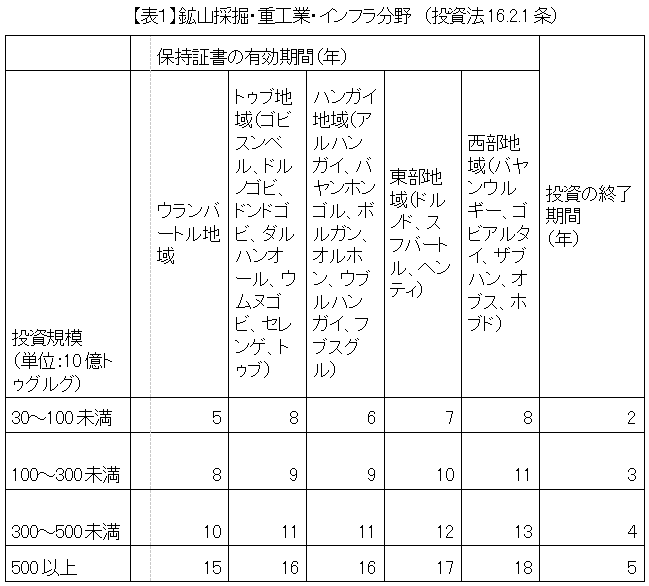
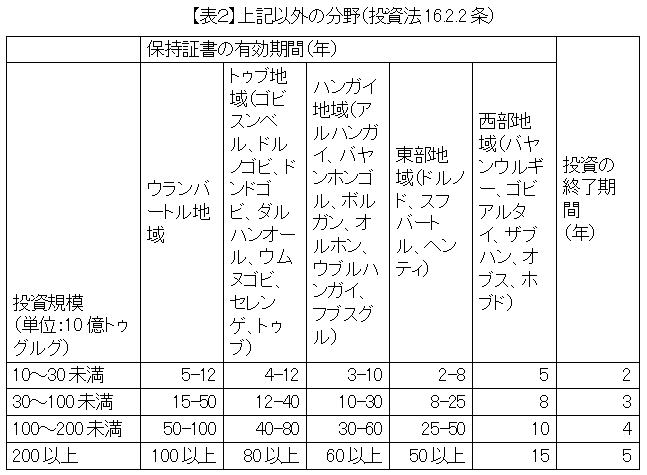
The above-mentioned period of investment is calculated from the issue date of the holding certificate. If you apply for extension and have permission, it will be extended in 2 years. Since the investment period will end even within the expiration date of the holding certificate, please keep in our mind that it is necessary to apply for extension of the investment period when continuing investment.
The following documents is required for the application of holding certificate (Article 17 of the Investment Act).
1. The report of the applicant corporation satisfying the conditions of the holding certificate
2. Introduction of the applicant who applied for, the register of the country, a special permit issued by the authority having the authority in the case where it is determined by law, and other copies of the warranty
3. Proof that advanced technology is being introduced
4. If determined by law, environmental assessment
5. If the investment scale of the project is less than 10 billion T gurugu, business plan, technical and economic support if over 10 billion Tugrug
The hold certificate will be informed of the issue possibility of issue within 30 days from the submission of the document. If necessary it will be extended for 15 days.
-
-
-
References
・ モンゴル財務省・ International Monetary Fund(国際通貨基金)‘World Economic Outlook’・ 独立行政法人国際協力機構(JICA)
-



 Japan
Japan UnitedStates
UnitedStates China
China Hong Kong
Hong Kong Mongolia
Mongolia Russia
Russia Thailand
Thailand Vietnam
Vietnam Laos
Laos Cambodia
Cambodia Myanmar
Myanmar Indonesia
Indonesia Philippines
Philippines Singapore
Singapore Malaysia
Malaysia India
India Bangladesh
Bangladesh Pakistan
Pakistan Sri Lanka
Sri Lanka Mexico
Mexico Brazil
Brazil Peru
Peru Colombia
Colombia Chile
Chile Argentina
Argentina DubaiAbuDhabi
DubaiAbuDhabi Turkey
Turkey South Africa
South Africa Nigeria
Nigeria Egypt
Egypt Morocco
Morocco Kenya
Kenya